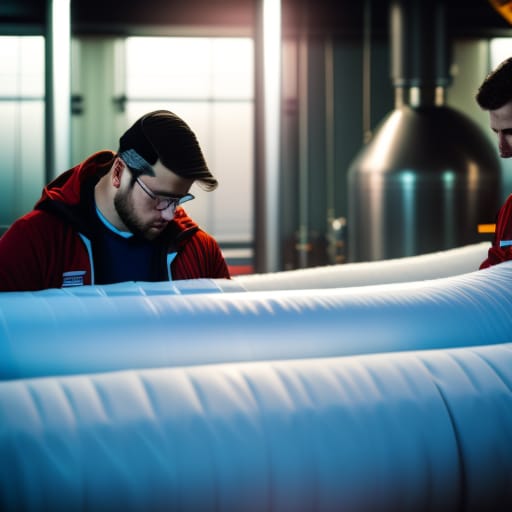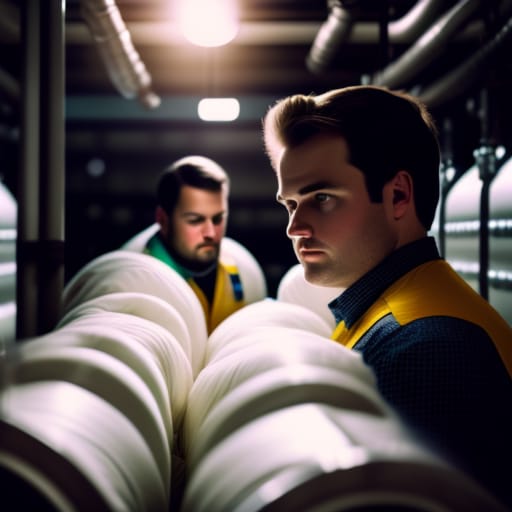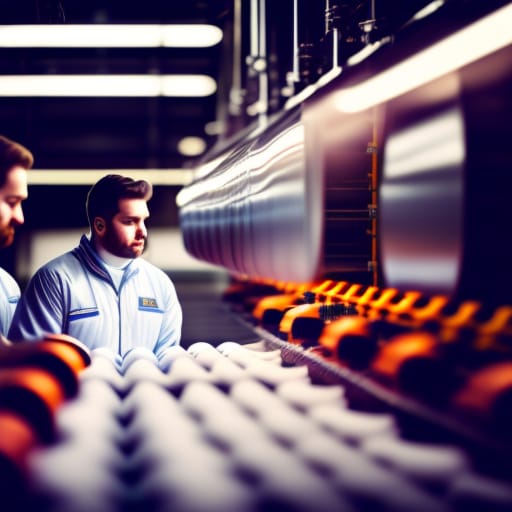Down comforters are the pinnacle of coziness. Their fluffy fill and lightweight warmth make them a favorite for beds around the world. But have you ever wondered exactly how these snuggly blankets get made?
The manufacturing process for down comforters is intricate, requiring specialized materials and techniques perfected over decades. In this beginner’s guide, we’ll walk through each step involved in creating a quality down comforter, from sourcing responsibly-obtained down to constructing the final product.
Understanding how down comforters are made can help you become a more informed shopper when choosing your next fluffy blanket. So let’s get started!
An Introduction to Down Comforters
A down comforter is a type of duvet or quilt filled with fine, fluffy down feathers from ducks or geese. The down creates loft and traps body heat, providing lightweight warmth that adjusts to your body temperature.
Down comforters offer superior insulation compared to comforters filled with less expensive synthetic alternatives like polyester. The clusters of down “trap” still air, creating thousands of tiny air pockets that retain and circulate heat. This allows down to provide exceptional warmth for its low weight.
The shell or outer fabric of a down comforter is typically made from materials like cotton, cotton sateen, silk, or polyester microfiber. The shell helps contain the down fill and prevent leakage.
Quality down comforters are designed to last for years with proper care. While more of an investment upfront, a good down comforter can save money in the long run compared to buying cheaper versions repeatedly.
Now let’s look at how these cozy blankets go from ducks and geese to the finished product keeping you warm at night.
Sourcing and Selecting Down
The down inside a comforter comes from ducks or geese during the natural molting process. Most down used in comforters today comes from geese. Duck down has similar insulating properties but is generally smaller and less durable.
Responsible Down Certifications
Reputable down suppliers adhere to standards that ensure the humane treatment of birds during down collection. Major certifications include:
- Responsible Down Standard (RDS): Ensures birds are never live-plucked or force-fed. Monitoring required at every stage from farm to product.
- Downpass: Traceability standard with an independent audit process covering animal welfare, ethics, and sustainability.
- Global Traceable Down Standard: Focuses on animal welfare and traceability from farm to finished product.
- European Down & Feather Association (EDFA): Sets standards for sustainability and animal welfare in European down production.
Choosing down certified through programs like these supports ethical sourcing.
Sources of Down
The majority of down comes from China and eastern Europe. However, many quality down suppliers source exclusively from Europe.
European down generally offers superior fill power and resilience compared to down from China. The climate in Europe allows geese to grow larger with bigger down clusters that provide better insulation.
Popular regions for European down include Hungary, Poland, France, and the Baltic regions. European down carries a higher price tag but can be worthwhile for high-end comforters.
Collecting and Preparing Down
Once responsibly sourced, the down goes through extensive cleaning, sorting, and prep to get it ready as fill material.
Humane Collection
Reputable suppliers only collect down during the natural molting seasons for waterfowl. The birds are treated humanely and never live-plucked.
After collection, the down gets cleaned multiple times to remove impurities. Advanced techniques like Ozonization can sterilize down at the molecular level.
Sorting Down by Quality
Next, the down is sorted by fill power and quality. Fill power measures the loft or fluffiness of down clusters. Higher fill power down will have larger, fuller clusters that trap more air.
The finest down with the highest fill power gets used in premium comforters. Lower grades may go into budget products or down alternatives. This sorting ensures the right down goes into each comforter.
Choosing the Shell Fabric
The outer shell of a down comforter plays several important roles:
- Contains the down fill
- Prevents fill from shifting around
- Allows airflow
- Provides a cozy, soft feel
Downproof Fabrics
The shell needs to be made from a downproof fabric that contains the tiny down particles. Popular options include:
- Cotton: Breathable and moisture-wicking but less durable over time. Pima or Egyptian cotton offer superior softness.
- Silk: Extremely soft and durable but more expensive. Provides warmth by itself.
- Polyester microfiber: Durable, affordable synthetic with downproof construction. May not feel as luxe.
Special downproof construction like tight weaves and double needle stitches keep down inside. Thread count indicates softness and durability–the higher the count, the better.
Baffle Boxes vs. Sew-Through
Higher end down comforters use a baffle-box design where the shell forms little fabric boxes that hold down compartments. This helps the fill stay evenly distributed.
Cheaper comforters are sew-through, with stitches going all the way through each layer. This can lead to down shifting around and cold spots over time.
Fill Power and Construction Matter
Now we’ll look “under the covers” at how fill power and interior construction impact down comforter performance.
Understanding Fill Power
As mentioned earlier, fill power measures the loft and thermal efficiency of down clusters. It ranges from around 450 to 900. Here’s a simple guide:
- 450-550 fill power: Budget price point
- 600-650 fill power: Mid-range quality
- 700+ fill power: Premium with maximum loft
Higher fill power down will be warmer, lighter, and fluffier. It also tends to be more durable and retain loft better over time.
Constructing the Interior
In addition to the shell fabric, construction of the interior compartments affects durability and insulation.
Baffle-box comforters have fabric walls that form separate down chambers. This prevents shifting and maintains even distribution of the fill.
Sew-through comforters lack these interior barriers, so the down can clump together. But they take less labor to construct.
The fill itself also needs to be distributed meticulously throughout the comforter for consistent performance.
Precision Manufacturing Process
Creating a quality down comforter requires specialized equipment and techniques perfected over many years.
High-Tech Sewing
The outer shell and interior baffles are assembled using advanced programmable multi-needle sewing machines. These machines perform hundreds of perfectly aligned stitches per minute.
This precision allows tiny perforations for airflow while keeping the fill contained. Different models apply the ideal stitch pattern for each fabric and application.
Preventing Leaks
Maintaining the integrity of the shell fabric during sewing is crucial. Manufacturers use methods like vacuum suction around the needles to prevent tiny down particles from escaping mid-stitch.
They also examine comforters inside and out during production to ensure no down is leaking through perforations in the shell. Any leaks get repaired immediately.
Filling the Comforter
Filling the comforter chambers evenly is an art and science. Down is added through small openings using manual and automated fill tubes.
Highly skilled workers gently distribute and fluff the down throughout the comforter to eliminate clumping. They may shake and massage the comforter to perfect the fill distribution by hand.
This meticulous process results in even warmth and loft across the entire comforter surface.

Rigorous Quality Control
Extensive testing during and after manufacturing catches any comforters that don’t meet quality standards.
Testing for Leaks
New comforters are placed inside vacuum chambers that generate extreme negative pressure. Any pinhole leaks in the shell will become immediately visible as down streams out.
This confirms no leaks were overlooked during production that could lead to down escaping over time.
Verifying Fill Distribution
Comforters also undergo loft distribution tests to ensure consistent, even fill. Laser precision thickness gauges identify any low spots that signal improper fill distribution.
Durability Testing
To assess durability, comforters get subjected to repeated tumble tests to simulate years of use. They must retain their shape, with no damage to the shell or shift in the fill.
Only comforters passing all quality checks earn the manufacturer’s guarantee. Rigorous standards ensure your down comforter will deliver lasting performance and enjoyment.
Down Alternative Comforters
For those seeking a down-free comforter, synthetic down alternative fills provide similar lightweight warmth.
The manufacturing process for down alternative comforters is comparable. The fill consists of polyester fibers engineered to mimic down clusters.
Popular down alternative fibers include 3M Thinsulate and PrimaLoft. These are shaped into wispy strands and siliconized to resist clumping when wet.
Performance vs. Real Down
Down alternative comforters can approach the feel and insulation of real down, usually at a lower price point. However, down still surpasses synthetic in a few key areas:
- Durability: Down lasts longer without losing loft
- Compressibility: Down is more packable for travel
- Breathability: Down allows better airflow to prevent overheating
So while down alternatives provide an affordable vegan option, natural down remains the gold standard for long-term performance.
Eco-Friendly Down Comforter Innovations
With sustainability in mind, manufacturers are finding innovative ways to reduce the environmental impact of down comforter production.
Recycled Down
Some brands like Carpenter Co. now offer comforters stuffed with recycled down and feathers. This gives new life to reclaimed materials that would otherwise go to waste.
By diverting waste from landfills, recycled down offers a more eco-friendly solution. Expect comforters to advertise higher percentages of recycled content in the future.
Responsibly Sourced Materials
From down to shell fabrics, each material in a comforter can promote sustainability.
For example, Coyuchi sources wool for its comforters from ranches with regenerative farming practices that enrich the soil. The end products even sequester carbon from the atmosphere.
Eco-conscious production methods like these reduce the carbon footprint at every step of manufacturing comforters.
Caring for your Down Comforter
To get the most out of your investment, proper care and cleaning are key. Here are some tips:
- Dry clean only: Avoid washing machines which can damage the shell and cause down clumping.
- Tumble dry low: Use tennis balls to fluff down after drying. Be sure the comforter is fully dry to prevent mildew.
- Store loosely: Don’t compress for long-term storage to maximize loft.
- Boost loft: Occasionally hang outside or tumble dry with clean tennis balls.
With careful use, a quality down comforter can last over 10 years, outlasting cheaper versions. Adequate care helps maintain both your comforter’s coziness and environmental sustainability.
Pushing the Boundaries of Down Innovation
While traditional techniques still dominate manufacturing, down comforter makers continue innovating in exciting ways.
Hand-Craftsmanship
Artisan down comforter brands like Feathered Friends employ meticulous detail and hand construction. Their heirloom-quality comforters can cost thousands yet remain cherished for generations.
These small batch products exemplify down craftsmanship at its finest. Modern technology balances with time-honored techniques.
Technical Advances
Larger manufacturers are also embracing technology to streamline production. They’re increasingly automating tasks like fill distribution and leak detection to boost efficiency and consistency.
3D knitting machines allow more intricate baffle-box designs. And new antibacterial coatings inhibit allergen growth to improve health and safety.
Market Trends and Challenges
The down comforter industry, like all manufacturing sectors, faces evolving market factors and sourcing hurdles.
Stock Shortages
Increasing worldwide demand combined with pandemic-related supply chain disruptions has led to down and feather shortages in recent years. Limited stock has forced brands to cut back on production volumes.
Many companies expect tight supplies to persist through 2023. Sourcing additional down requires long-term investments, like raising more geese. So constraints may continue for some time.
Growth of Bedding Refresh Cycles
Consumer research shows people are replacing bedding more often, around every 5 years instead of 10.
Down comforters need to strike a balance between quality construction and reasonable pricing given this faster refresh cycle. Finding this sweet spot will be key to thriving in the current market.

Expert Tips for Choosing the Best Down Comforter
To close out this beginner’s guide, here are some pro tips from down bedding experts on selecting the perfect comforter for your needs:
“Focus on fill power first. Aim for at least 600 fill power for a comforter that will feel wonderfully plush yet remain lightweight enough for year-round use.” – Lindsay Stokke, Co-founder of Brooklinen
“Think about your climate. If you live in a warmer location, choose lighter, lower fill power down for breathability. Those in colder regions should look for higher fill power around 700-800.” – Jack Mitcham, Founder of Down & Feather Co.
“Don’t forget about the shell fabric – it should be durable, breathable and soothing to sleep against. I recommend pima cotton or cotton sateen for the best user experience.” – Leanne Stapf, CEO of The Company Store
“For a green choice, look for certifications like the RDS that ensure responsible sourcing. Bonus points for recycled down fill. This ensures your comforter aligns with your values.” – Chris Colton, CEO of Coyuchi
Whether you seek a plush, luxurious comforter or a lightweight version for hot sleepers, understanding what goes into manufacturing down comforters helps you find your perfect match. With proper care, a quality down comforter can promote restful sleep for years to come. Just be sure to give it a fluff before climbing in each night to enjoy its amazing coziness!
Frequently Asked Questions
What is the best fill power for a down comforter?
The fill power measures the fluffiness and warmth of the down inside a comforter. Most experts recommend looking for comforters with at least 600 fill power. 700-800 fill power is ideal for maximum loft and insulation without excessive weight.
How do I know if a down comforter is high quality?
Look for comforters with baffle-box construction, high thread count shell fabrics like Egyptian cotton, and fill power of 600 or above. Responsible Down Standard (RDS) certification also indicates quality materials and manufacturing. Testing for durability, evenly distributed fill, and down leakage ensures excellent longevity.
Why are European down comforters considered superior?
European down comes from larger geese and often has higher fill power around 700-900. This results in better loft, resilience and temperature regulation compared to down from China. European down’s exceptional quality helps down comforters maintain plush insulation over years of use.
How often should I clean my down comforter?
Most experts recommend dry cleaning down comforters every 2-3 years to revitalize loft and remove body oils. Spot clean minor stains as needed. Use duvet covers to protect the comforter between professional cleanings. Proper care extends the longevity of your investment.
What’s the difference between down and down alternative?
Down alternative comforters use polyester fibers to simulate the qualities of real down. But down still surpasses synthetic alternatives in durability, breathability, and compressibility. Down also provides unmatched plushness and lightweight warmth over time. While cheaper, down alternative can’t fully replicate the cozy sleeping experience of premium down.








